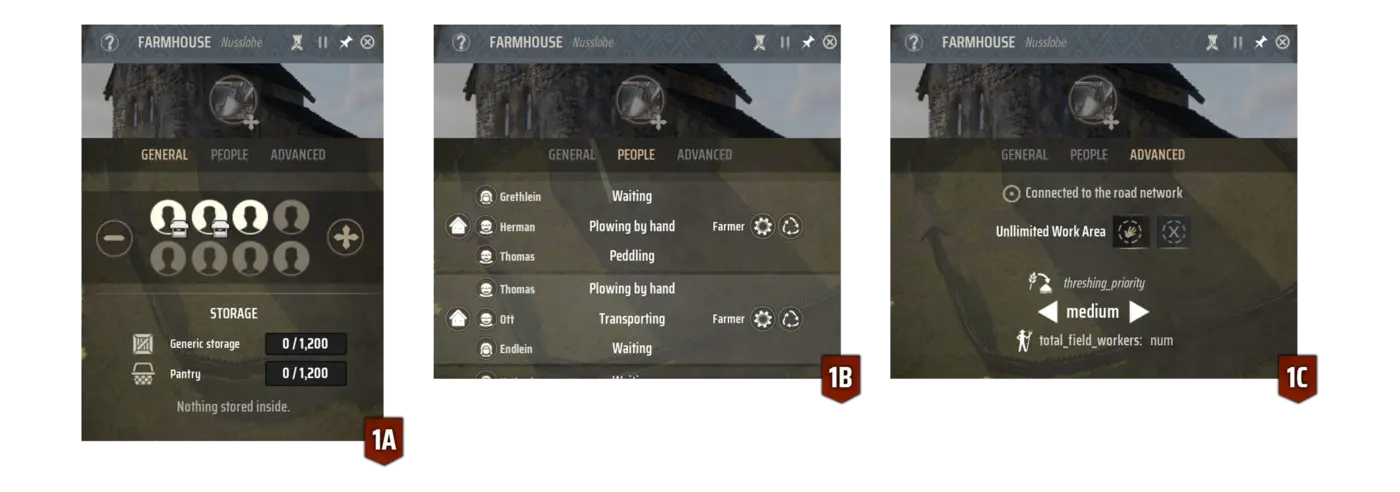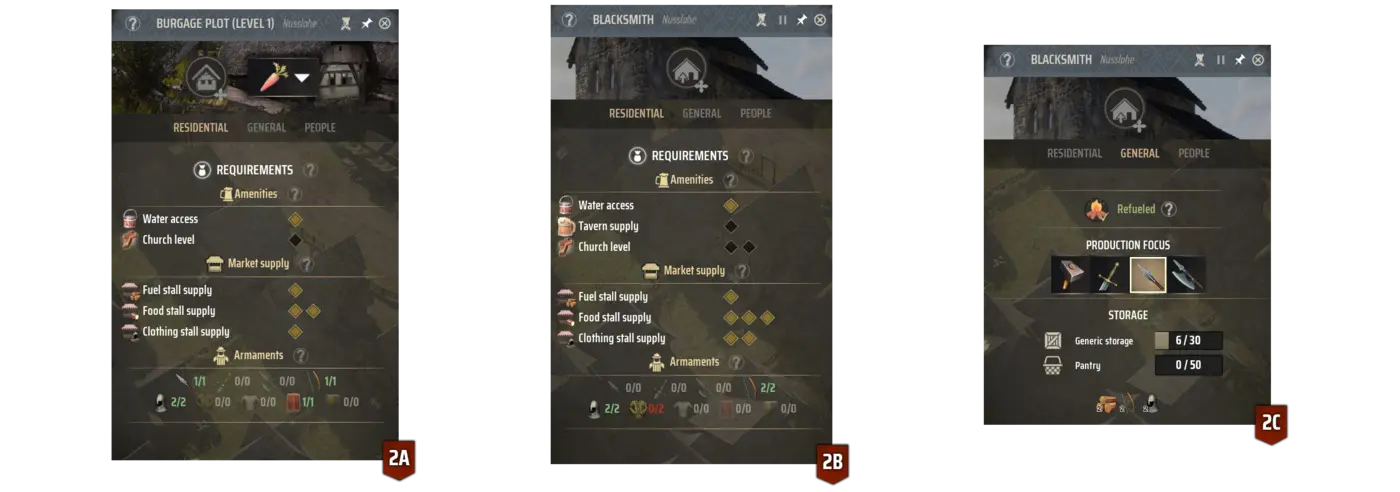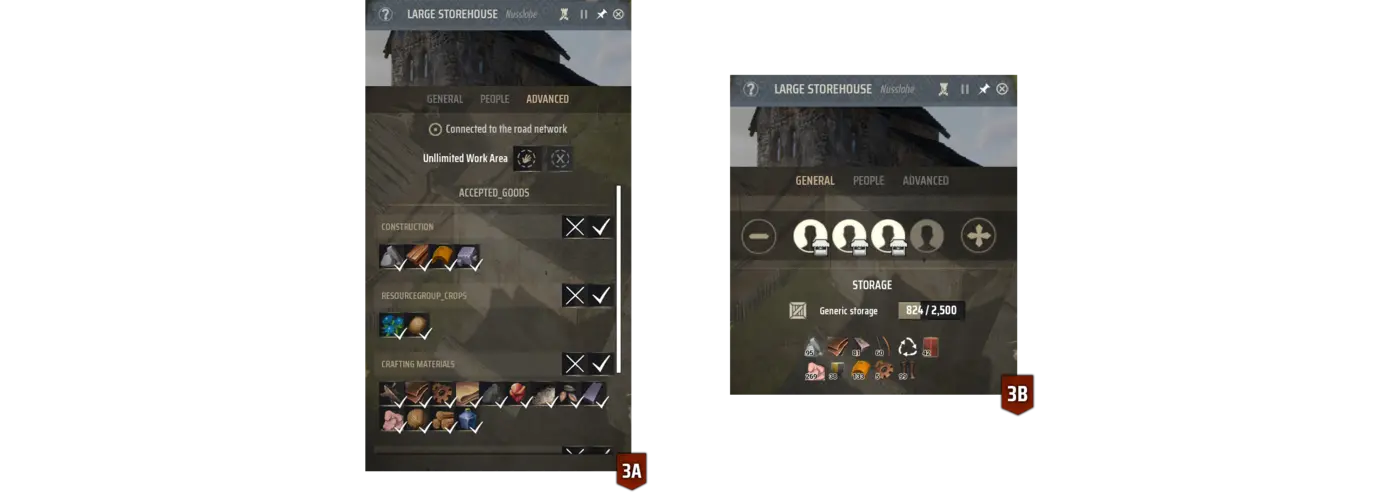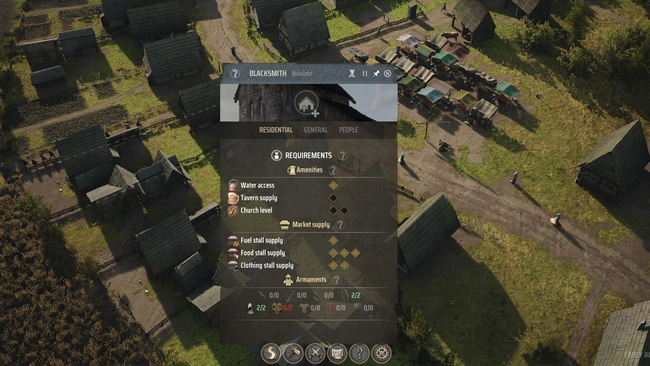Table of Contents Show
You will often engage with three building interactions in Manor Lords: Production, Residential, and Storage.
Manor Lords Building Interactions
Production Buildings
Most production buildings follow these three-tab structures.

- 1a – General – Allows you to assign or remove families from working the selected building and provides an overview of the goods contained within it or any base goods that this building will need to refine into a processed good.
- 1b – People – This shows the location of all family members employed by the building and their current status. You can also see where their homes are relative to the workplace, allowing for some optimization if you want to minimize distance between a family and its work place. To assign a family to a new job, select the cog under the People tab and then select which building you want to them to then work in.
- 1c – Advanced – The options here vary based on the type of building. Some buildings allow you to assign a dedicated Ox, for example, others allow you to define a specific area to be worked on.
Residential Buildings
There are several tiers of residential housing, but the basics of how they operate and what you’re looking out for are what we will cover here.

- 2a – Level 1 House – Every house will need to have various needs met to avoid approval loss, split across “Amenities” and “Market Supply”. In this example of a Level 1 Burgage Plot, you can see the only unmet need is “Church level.” This means no Church has been built at all.
- The household will not be able to upgrade to Level 2 until this need has been met.
- Burgage plots that are large enough can construct a backyard extension, which gives you a few options. In this example, a vegetable garden was built at this house.
- 2b – Level 2 House – As you upgrade a house to a higher tier, there will be either be an increase of previous requirements or entirely new ones in the Residential panel.
- As you can see in example 2B, this level two house (which has also been designated as a “Blacksmith” Artisan) requires one extra point in Church level, Food Stall supply, and Clothing Stall supply, as well as the new Amenity requirement of “Tavern supply.”
- 2c – Artisans – As previously mentioned, houses that reach Level 2 can be further specialized into Artisans, removing them from the general labor pool and focusing the entire household on making a specific good. In this case, we have a Blacksmith.
- The General tab will display various information such as whether the production side of things is fueled (separate from the house’s basic fuel requirement), and if applicable you can choose what good the household should focus on making.
- General storage information for all tiers (artisan or otherwise) is also displayed on this tab.
**Note that the armaments at the bottom of the screen show the equipment your male family members will use when the militia is called into action.
- There are a few other important things to note about Residential Buildings:
- Water access never changes – as long as there is a well within the region, this need will be met.
- In Amenities, each point means something slightly different depending on the good in question – hover over the diamonds for an explanation of what each requirement means. For example, three diamonds for food means the market needs at least three different types of food available for sale.
- It’s not explicit what effect the size of a burgage plot has on backyard extension output. For things like the vegetable patch, bigger is better however the bigger the garden is, the longer it takes to work.
- For things like Goats (for hides) and Chickens (for Eggs), the plot size has no effect on output.
- Travel time between a dwelling and place of work can affect output, as the more time a family member spends traveling, the less time they have to work the backyard extension before returning to work.
- If you don’t meet the needs of your residents and approval gets too low, families will start leaving your village.
- Artisan households can still be called up to join the militia, and they generate regional wealth.
Storage Buildings

There are two types of storage buildings. Granaries store food and food-related goods, while storehouses contain non-food-related goods. Storage buildings require workers to collect, store, and distribute these goods. Either a storage worker, or the relevant “goods” worker (for example a firewood worker) will automatically set up stalls at the marketplace, provided one has been established to distribute the stored goods to your burgage plots.
Storage buildings have a capacity, and you can toggle what goods are stored there. Certain goods can degrade during inclement weather, so it is vitally important to have storage buildings throughout the settlement.
